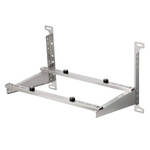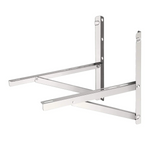Summer is here! Many people are starting to shut their furnaces off for the season as they prepare to dust off their air conditioners to help cool their homes.
If you have ever shopped for a new air conditioner, you probably noticed a few abbreviations that show up repeatedly: EER, CEER, and SEER. Recently, newer ratings like SEER2 and HSPF2 have also become important. Some of these ratings only apply to certain types of units (central air systems vs. window units, for example), but they all measure energy efficiency in air conditioners.
Some of the ratings only apply to some types of units (central air systems vs window units, for example), but these three terms are energy efficiency ratings used for air conditioners.
Summary
- EER: Measures efficiency at a specific temperature (95°F). Higher EER means higher efficiency.
- CEER: Accounts for both operating and standby power usage, providing a realistic measure of room air conditioner efficiency.
- SEER: Measures seasonal efficiency for central air systems. Higher SEER means higher efficiency over a cooling season.
- SEER2: An updated version of SEER, providing a more accurate representation of seasonal efficiency with modern testing standards.
- HSPF2: Measures the seasonal heating efficiency of heat pumps, reflecting modern testing and broader operating conditions.
Understanding these ratings can help you select an air conditioner or heat pump that not only cools or heats your home effectively but also uses energy efficiently, saving you money on energy bills in the long run.
Let’s take a look at these ratings in more detail.
EER (ENERGY EFFICIENCY RATIO)
EER measures how efficiently an AC system will operate when the outdoor temperature is at a specific level. EER is measured by taking the unit’s energy consumption while cooling 95°F air over the course of an hour in a climate-controlled laboratory setting. It is calculated by dividing the cooling capacity in BTUs per hour (BTUH) by the power input in watts. EER is expressed as BTUH/watts. The higher the EER, the more efficient the system will be.
For example, window units only need to achieve between 9.4 and 10.7 EER, depending on BTU size, in order to receive Energy Star Certification. Energy Star certified room air conditioners use 10 percent less energy than non-Energy Star certified units and, on average, cost less than $70 per year to run.

CEER (COMBINED ENERGY EFFICIENCY RATIO)
CEER became the new standard by which window/room air conditioners are rated by the DOE (Department of Energy) in June 2014. It takes into account the energy used while the air conditioner is running as well as the standby power used when the unit is not running but is powered on.
CEER allows you to have a more accurate estimate of the overall realistic energy efficiency of room air conditioners. It also takes the standby power usage into account, not just the operating efficiency as in the EER rating.

SEER (SEASONAL ENERGY EFFICIENCY RATIO)
SEER is used to measure the efficiency of a central air conditioner system. SEER measures how efficiently a cooling system will operate over an entire season. The higher the SEER, the more efficient the system.
Window air conditioners do not have a SEER rating (and have lower ratings overall) because it’s impossible to fit the advanced hardware used in a central air cooling system into that little box that hangs outside of your window. While modern central air conditioners can work at a range of speeds, for example, the condensers in most window units only have two speeds: on and off. This is the primary reason window air conditioners don’t get SEER ratings and instead use EER and CEER ratings.

SEER2 (Seasonal Energy Efficiency Ratio 2)
SEER2 is an updated version of the SEER rating, providing a more accurate representation of a system’s efficiency by considering a broader range of operating conditions and updated testing procedures. SEER2 reflects improvements in both technology and testing methodologies to ensure consumers get a more precise measure of seasonal energy efficiency.
The higher the SEER2 rating, the more efficiently the system operates over a typical cooling season. SEER2 is especially useful for comparing newer models of central air conditioners, as it accounts for the latest advancements in HVAC technology.
HSPF2 (Heating Seasonal Performance Factor 2)
HSPF2 is a rating for heat pumps that measure their heating efficiency over a typical heating season. Similar to how SEER2 updates the SEER rating, HSPF2 provides a more accurate measure of a heat pump’s performance by incorporating updated testing procedures and broader operating conditions.
The HSPF2 rating is calculated by dividing the total heating output of the heat pump during the heating season by the total electricity consumed. A higher HSPF2 indicates a more efficient heat pump, which translates to lower energy bills and better performance in colder climates.
TOSOT AC Energy Efficiency Reference Chart
To help simplify your buying decision, we put together this handy reference chart that tells you the type of unit, model name, BTU, and energy efficiency ratings for every type of AC unit we offer.
To use this chart, pick the type of unit you want (portable, window, etc) and find one to match your application area. Make sure you don’t choose a unit that is too underpowered or overpowered for your space, as this can reduce the efficiency and comfort level of the room you are trying to cool.
|
Type |
Model |
Cooling BTUs |
Application Area |
EER |
CEER |
SEER |
SEER2 |
HSPF2 |
|
Portable |
Shiny |
8,000 |
300 sq ft |
10.24 |
6.1 |
N/A |
N/A |
N/A |
|
10,000 |
400 sq ft |
9.9 |
6.8 |
N/A |
N/A |
N/A |
||
|
Aovia |
9,000 |
250 sq ft |
10.1 |
6.4 |
N/A |
N/A |
N/A |
|
|
10,000 |
300 sq ft |
10.1 |
6.6 |
N/A |
N/A |
N/A |
||
|
Aolis |
12,000 |
450 sq ft |
9.7 |
7.3 |
N/A |
N/A |
N/A |
|
|
Aomi |
12,000 |
400 sq ft |
9.2 |
N/A |
N/A |
N/A |
N/A |
|
|
Aomi |
14,000 |
600 sq ft |
10.5 |
N/A |
N/A |
N/A |
N/A |
|
|
Window |
Tranquility |
8,000 |
350 sq ft |
12.1 |
12.0 |
N/A |
N/A |
N/A |
|
Chalet |
8,000 |
350 sq ft |
12.1 |
12.0 |
N/A |
N/A |
N/A |
|
|
10,000 |
450 sq ft |
12.1 |
12.0 |
N/A |
N/A |
N/A |
||
|
12,000 |
550 sq ft |
12.1 |
12.0 |
N/A |
N/A |
N/A |
||
|
Mini-Split |
Muse (120V) |
9,000 |
450 sq ft |
12.5 |
N/A |
20.00 |
20.0 |
8.6 |
|
Muse (230V) |
9,000 |
450 sq ft |
12.8 |
N/A |
20.5 |
20.5 |
8.8 |
|
|
Muse (120V) |
12,000 |
650 sq ft |
10.24 |
N/A |
20.0 |
20.0 |
8.5 |
|
|
Muse (230V) |
12,000 |
650 sq ft |
11.0 |
N/A |
20.0 |
20.0 |
8.5 |
|
|
Muse (230V) |
18,000 |
850 sq ft |
10.59 |
N/A |
19.5 |
20.0 |
8.5 |
|
|
Muse (230V) |
24,000 |
850 sw ft |
10.9 |
N/A |
19.5 |
20.0 |
8.5 |
Check out our line of Mini Split, Window, and Portable air conditioners to fit your space and keep you cool this summer!
If you have any questions about choosing the perfect air conditioner for your home, reach out to our support team and we will be happy to help you out.






